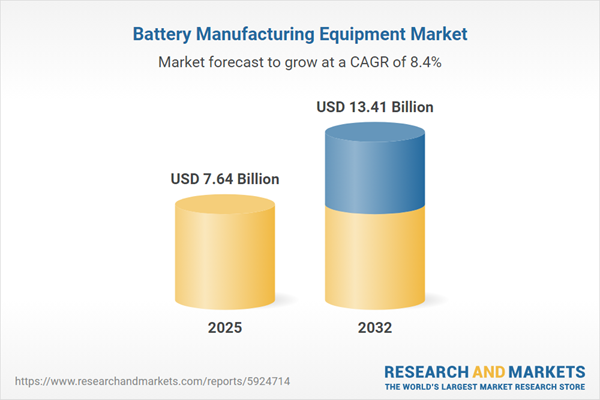Speak directly to the analyst to clarify any post sales queries you may have.
Senior decision-makers face ongoing challenges in battery manufacturing as evolving technology and supply chain dynamics change the way global operations are managed. Navigating this fast-shifting landscape requires embracing agile manufacturing strategies to outpace industry disruptions.
Market Snapshot: Battery Manufacturing Equipment Market Overview
The global battery manufacturing equipment market is projected to grow strongly, with its value rising from USD 7.05 billion in 2024 to USD 7.64 billion in 2025, reaching USD 13.41 billion by 2032. This reflects a compound annual growth rate (CAGR) of 8.36%. Expansion is fueled by increased adoption of advanced energy storage solutions, especially as electric vehicles, infrastructure upgrades, and electronics require higher performance, efficiency, and reliability. Leading manufacturers are accelerating the shift toward automation and digitalization, integrating modular systems that enhance scalability. Current market trends include increasing product variety and renewed focus on strengthening supply networks to meet global and regional needs.
Scope & Segmentation of the Battery Manufacturing Equipment Market
This report analyzes the battery manufacturing equipment market’s core elements, mapping technological advancements and regional growth patterns essential for informed investment and business planning. It enables strategic segmentation to facilitate clear decision-making across all organizational levels.
- Equipment Types: Cell assembly units, electrode coating machinery, formation and aging systems, mixing apparatus, and inspection devices shape efficient, modern production lines by supporting high-speed, high-precision manufacturing.
- Battery Types: Flow batteries, lead-acid varieties, lithium-ion progressions, and nickel metal hydride batteries highlight specific operational and safety demands, guiding equipment and process configuration.
- Cell Form Factors: Machinery addresses cylindrical, prismatic, and pouch cell designs, affecting facility layout, automation levels, and capital investments for volume production or specialized use-cases.
- End Use Industries: Automotive (including BEV, HEV, PHEV), industrial, consumer electronics, and sectors such as commercial, residential, and grid storage specify distinct requirements for equipment upgrades and capital allocations.
- Production Capacities: Solutions support low-, medium-, or high-volume production, helping organizations align throughput, footprint, and quality control with desired business outcomes.
- Automation Levels: Options range from manual to fully automated systems, allowing customization based on technology maturity, operational budgets, and integration needs.
- Regional Coverage: Analysis spans North America, Latin America, Europe, Middle East, Africa, and Asia-Pacific, with particular attention on East Asian, South Asian, and Southeast Asian hubs, reflecting their rapid adoption rates and impact on global supply structures.
Key Takeaways for Decision Makers
- Organizations are integrating robotics, artificial intelligence, and digital twin tools to drive operational efficiency and consistent product quality, leveraging real-time analytics for better plant management.
- Regulatory and sustainability imperatives are prompting a shift toward equipment that supports resource optimization, waste reduction, and alignment with circular economy models, supporting longer-term competitiveness.
- Collaborative initiatives among OEMs, suppliers, and research bodies are accelerating process standardization, improving system interoperability, and enabling faster adoption of next-generation technologies.
- Diversified sourcing and expanding supplier networks support enhanced supply chain resilience, reducing vulnerability to disruptions and regulatory shifts.
- Innovative service models such as predictive maintenance and performance-based contracts contribute to continuous uptime and support strategic budgeting for equipment over its lifecycle.
Tariff Impact on Battery Manufacturing Equipment Ecosystems
The upcoming United States trade tariffs in 2025 will heighten costs and increase operational complexity for domestic battery manufacturing equipment suppliers. This market shift encourages local sourcing and regional partnerships, while new competitors are entering the space. Capital investment plans are being adapted, with firms prioritizing flexible operating models and new alliances to secure reliable supply and stay compliant with regulations.
Methodology & Data Sources
A robust mixed-method approach underpins this analysis. Primary data was gathered from interviews with OEM executives and operations leaders. The research also reviewed corporate disclosures, patent filings, regulatory records, and market intelligence insights. Quantitative models and expert panel input validate segmentation and ensure reliability.
Why This Report Matters
- Empowers decision-makers to anticipate market trends and align equipment strategies with emerging technologies and automation imperatives.
- Facilitates effective production, risk, and compliance planning through strategic segmentation and clear understanding of regional market differences.
- Prepares organizations to capture new opportunities and adapt to evolving customer and regulatory expectations in a dynamic sector.
Conclusion
This report provides the strategic insight needed to adapt investment, optimize machinery choices, and maintain competitiveness in the changing battery manufacturing equipment market.
Additional Product Information:
- Purchase of this report includes 1 year online access with quarterly updates.
- This report can be updated on request. Please contact our Customer Experience team using the Ask a Question widget on our website.
Table of Contents
3. Executive Summary
4. Market Overview
7. Cumulative Impact of Artificial Intelligence 2025
Samples

LOADING...
Companies Mentioned
The key companies profiled in this Battery Manufacturing Equipment market report include:- Manz AG
- Bühler AG
- Nordson Corporation
- ULVAC, Inc.
- Applied Materials, Inc.
- AMETEK, Inc.
- Ecopro BM Co., Ltd.
- Komax Holding AG
- GEA Group AG
- Sakamura Machine Co., Ltd.
Table Information
| Report Attribute | Details |
|---|---|
| No. of Pages | 192 |
| Published | October 2025 |
| Forecast Period | 2025 - 2032 |
| Estimated Market Value ( USD | $ 7.64 Billion |
| Forecasted Market Value ( USD | $ 13.41 Billion |
| Compound Annual Growth Rate | 8.3% |
| Regions Covered | Global |
| No. of Companies Mentioned | 11 |









